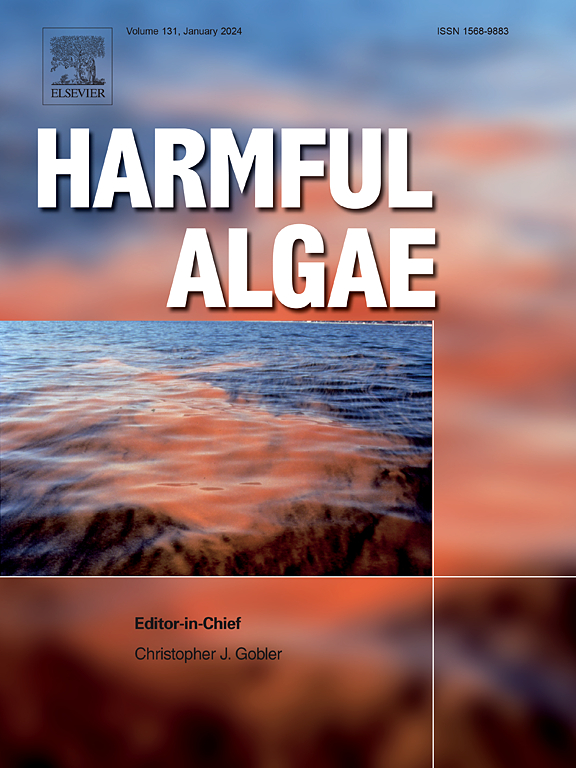北极和波罗的海产毒亚历山大藻对不同气候变化胁迫的生理响应
IF 4.5
1区 生物学
Q1 MARINE & FRESHWATER BIOLOGY
引用次数: 0
摘要
从极地到热带,从海洋到咸淡水,有害藻华种类亚历山大藻在世界范围内都有分布。在Alexandrium属的其他物种中,它是麻痹性贝类毒素的致病生物之一,但此外,A. oponfeldii也被证明能产生另一类毒素,环亚胺。南菖蒲的广泛分布表明,它们对多种环境参数有特定的适应,因此对全球变化驱动因素(如变暖和海面盐度变化)有不同的反应。在本研究中,我们量化了来自北极Kongsfjord和来自北欧波罗的海的两株A. ostfeldii菌株在不同温度条件下的生长和毒素细胞配额,以评估全球变暖对当地适应种群的影响。总的来说,北极菌株的生长温度在7.5℃至20℃之间,两种菌株的最大生长速度都在15℃。来自波罗的海的两个菌株在热耐受性方面显示出种内差异。其中一株在25°C条件下没有生长,而另一株在27°C条件下仍有正生长速率。此外,其中三个菌株暴露于10至40的盐度,显示出对广泛盐度的耐受性。温度和盐度都不影响任何菌株的定性毒素组成,但我们在四个测试菌株中的三个中检测到新的环亚胺。此外,不同的温度和盐度导致毒素细胞总配额的动态变化。此外,我们在两个北极菌株中检测到新的螺内酯类。这些研究结果表明,北极地区的A. ostfeldii可能会从全球变暖中受益,而波罗的海的种群可能不会,并且由于气候变化导致该地区盐度下降,波罗的海可能对该地区西部的A. ostfeldii不利。本文章由计算机程序翻译,如有差异,请以英文原文为准。
Physiological responses of Arctic and Baltic Sea populations of toxigenic Alexandrium ostenfeldii (Dinophyceae) to different climate change stressors
The harmful algal bloom species Alexandrium ostenfeldii has a worldwide distribution from polar to tropical habitats and from oceanic to brackish waters. Among other species of the genus Alexandrium, it is one of the causative organisms of paralytic shellfish toxins, but additionally, A. ostenfeldii has also been shown to produce another class of toxins, cyclic imines. The wide distribution of A. ostenfeldii suggests population-specific adaptations to a multitude of environmental parameters and therefore, variable responses to global change drivers, such as warming and shifts in sea surface salinity. In this study we quantified growth and toxin cell quota of two strains of A. ostenfeldii isolated from the arctic Kongsfjord and two strains from the northern European Baltic Sea at various temperature conditions, to assess the impact of global warming on locally adapted populations. Overall, growth of the arctic strains was detected at temperatures between 7.5 and 20 °C, with a maximum growth rate at 15 °C for both strains. The two strains from the Baltic Sea revealed intraspecific differences concerning their thermal tolerance. One strain showed no growth at 25 °C, while the other still had a positive growth rate at 27 °C. Furthermore, three of the strains were exposed to salinities between 10 and 40, revealing a tolerance to a broad range of salinities. Neither temperature nor salinity affected the qualitative toxin composition of any strain, but we detected novel cyclic imines in three of the four tested strains. Furthermore, different temperatures and salinities led to dynamic shifts in total toxin cell quota. Additionally, we detected novel spirolides in both arctic strains of A. ostenfeldii. These findings suggest that arctic A. ostenfeldii might significantly benefit from global warming, while populations from the Baltic Sea may not, and that the Baltic Sea might become unfavourable for western Baltic A. ostenfeldii due to climate change driven decreasing salinity in this area.
求助全文
通过发布文献求助,成功后即可免费获取论文全文。
去求助
来源期刊

Harmful Algae
生物-海洋与淡水生物学
CiteScore
12.50
自引率
15.20%
发文量
122
审稿时长
7.5 months
期刊介绍:
This journal provides a forum to promote knowledge of harmful microalgae and macroalgae, including cyanobacteria, as well as monitoring, management and control of these organisms.
 求助内容:
求助内容: 应助结果提醒方式:
应助结果提醒方式:


